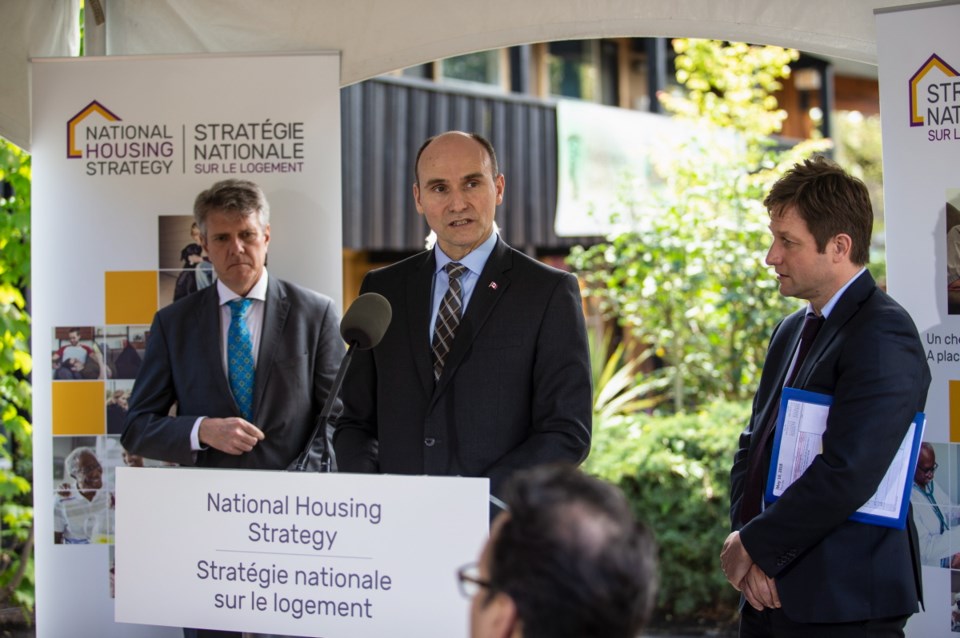Will a $90-million affordable housing initiative by federal, provincial and regional governments actually create 2,010 rental units in Greater Victoria over the next four years?
Casey Edge, executive director of the Victoria Residential Builders Association, said he needs more information on land, construction and permit costs to answer that question.
“Any time the government steps up to address affordable housing, it’s a good thing,” Edge said Friday. “That said, what will $90 million actually buy?”
On Thursday, Jean-Yves Duclos, federal minister of families, children and social development, announced Ottawa would match $30-million investments by both the province and Capital Regional District to support housing needs in Greater Victoria. Victoria Mayor Lisa Helps said the investment will build at least 2,010 rental units over the next four years and end chronic homelessness in the region.
The housing will include 985 market-rental units, 625 affordable-rental units and 400 shelter-rate units for people on provincial assistance who will pay $375 a month. The goal is to have 30 to 40 rental buildings under construction by the end of 2021.
Edge said the City of Victoria has one of the most challenging and costly permit processes in the region.
“I don’t know if the plan is to fast-track or provide special exemptions for these units. The question is where are they getting their numbers from? What are the land costs? What are the construction costs? What do they anticipate permit costs will be?”
Greater Victoria also has some of the highest land costs in North America. “We have community groups saying we want low density, we want lots of green space and we want affordable housing. Well, the numbers won’t work,” said Edge. A 50-year-old house on a 13,000-square foot lot in Saanich, for example, is assessed at $100,000 for the house, but $700,000 for the land, he said.
He would like to see an inventory of municipal, provincial and federal land for housing. “The federal government is coming to the table with $30 million. Why don’t they come to the table with some land?”
The real challenge in the community is housing affordability for young people and people starting families, Edge said.
The additional 2,010 units will increase the housing stock in Greater Victoria by only one per cent. It will not have a significant impact on housing affordability, Edge said.
“We operate in a very regulated market. The government tells us where we can build, how much we can build through zoning, how we must build through the building code and the timing of the build. It can take years to put up a development.”
There are 13 municipalities with 13 different community plans. Developers often find themselves battling against community associations and councils for higher density, he said.
“Langford is the most foresighted, affordable and efficient municipality in the CRD. It has gone a long way to address housing affordability so young millennials can afford to buy and build a home in Langford. In most other municipalities, it’s not possible because of the land costs.”
Ten years ago, architect Alan Lowe was chair of the Coalition to End Homelessness. On Friday, the former Victoria mayor said it’s great to see all levels of government coming together to try to make a dent in homelessness.
“It’s good to see funds are going to various types of housing. The extra 2,000 units are going to make a huge difference. This injection of funding is going to allow those that can’t afford the higher rents to find shelter.”
There hasn’t been a program in 30 years that encourages people to build rental housing, Lowe said, though in the past few years, some has been built because of demand and low interest rates.
Agencies involved in the funding need to find the right mix of tenants — whether it’s a 20 per cent shelter rate or five per cent shelter rate — to make the project a success so there’s no stigma or fear of people who are just off the streets, Lowe said.
“The fear can be gotten rid of by having some success stories,” Lowe said. “Support services are required. If that doesn’t happen, nobody will want those buildings in their neighbourhood.”



